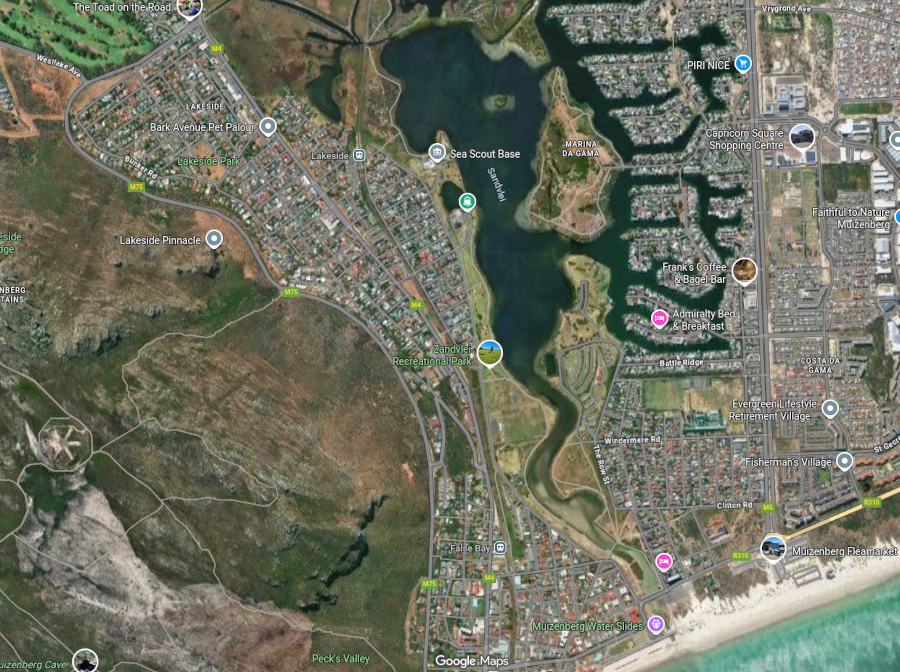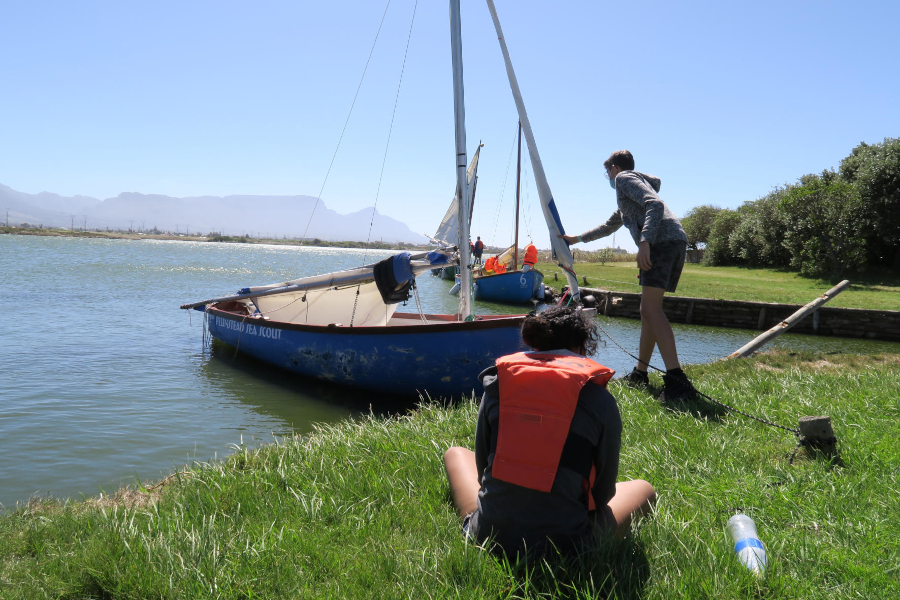Scientists show pollution of the estuary is not sufficiently diluted, but persists in the environment
Sewage pollution is believed to be causing the persistent presence of drugs such as paracetamol and antibiotics in the ecologically important Zandvlei Estuary at Muizenberg, Cape Town.
According to a paper recently published in the journal Water by scientists from the University of Cape Town and the University of the Western Cape, concentration of pharmaceuticals in the estuary are 100-fold greater than those in False Bay, into which it flows.
False Bay, which receives effluent from seven sewage treatment works between Gordon’s Bay and Miller’s Point – the three largest of which are failing to treat effluent to minimum standards – has also been shown to be contaminated, with pharmaceutical compounds found in the flesh and organs of fish sold at Kalk Bay harbour. The antibiotic sulfamethoxazole, which was one of a number of pharmaceutical compounds found in the fish, is the same antibiotic found accumulating in sand prawns in Zandvlei.
The pharmaceuticals are known to be contained in sewage, as a large percentage of the drug is not absorbed by the body, but is excreted.
But even the most well-run conventional sewage treatment plants are not designed to remove pharmaceuticals, and other persistent organic pollutants (carbon-based chemical compounds which resist degradation in the natural environment), from wastewater.
Authors Olivia Murgatroyd, Leslie Petrik, Cecilia Y. Ojemaye, and Deena Pillay state pharmaceuticals are increasingly detected in coastal ecosystems around the world, but the extent of contamination, and bioaccumulation (the increase in chemicals in an organism over time) has not been sufficiently studied in estuaries which are temporary closed to the ocean, as is the case at Zandvlei.
Ecological importance
While many estuaries are temporarily closed by naturally occurring sandbars, Zandvlei has been subject to urban development and is regularly closed by a grader operated by the City of Cape Town, by creating a man-made sandbar, partly to manage flood levels affecting the Marina Da Gama development on the estuary’s eastern banks. The temporary closures result in pollutants building up in the estuary, and being taken up by organisms such as sand prawns.
Zandvlei is the only combination of estuary, wetland, and river system on the False Bay coast, and is important as a fish nursery and a habitat for many birds and other animals. According to the Zandvlei Trust, it is also home to “various endangered species” that are on the red data list.
But the vlei is ecologically degraded. Murgatroyd et al. state Zandvlei is classified as eutrophic, which means it suffers from excessive plant and algal growth due to high levels of nutrients such as nitrogen and phosphorous, which are present in sewage and agricultural fertilisers. When this plant growth dies, it sinks to the bottom and removes oxygen from the water through the process of decay. This is also partly why the City has commissioned a new weed harvester to remove weeds and algae from the estuary.
Zandvlei receives runoff from farm land in Steenberg and Constantia, and from polluted canals threading through urban areas such as Retreat and Steenberg. It is also occasionally polluted by sewage spills from pump station failures.
Pharmaceutical analysis
In their paper Persistent Pharmaceuticals in a South African Urban Estuary and Bioaccumulation in Endobenthic Sandprawns, Murgatroyd et al. state they took water samples from fives places in the estuary during August 2022. The sample sites ranged from the northern (inland) part of the estuary, near the mouth, and the Marina Da Gama waterways. Sand prawn were also collected and analysed.
The scientists tested the water samples and sand prawns for acetaminophen (Panado), amitriptyline (an anti-depressant), bezafibrate (used to lower cholestrol), carbamazepine (anti-convulsant, used to treat seizures), diclofenac (an anti-inflammatory, active ingredient in Voltaren), nevirapine (used to manage HIV infection), and sulfamethoxazole (an antibiotic).
These chemicals have previously been detected in sewage, and in False Bay, state the authors.
All were found in water and sand prawn samples. In the water samples, acetaminophen was the most concentrated (up to 2.231 micrograms per litre. It was also the most concentrated in sand prawns, followed by carbamazepine (1.879 to 5.695 micrograms/g dry weight), sulfamethoxazole (0.480 to 2.094 micrograms/g dry weight) and nevirapine (up to 0.359 micrograms/g dry weight).
The bioaccumulation factor for nevirapine was the greatest, followed by carbamazepine, sulfamethoxazole, and acetaminophen. Diclofenac, amitriptyline and bezafibrate had the lowest bioaccumulation factors.
The authors state that while these pollutants may occur at low concentrations (measured in micrograms), they are designed to be biologically active at low levels.
Global pollution leader
Looking at other studies, the authors note Zandvlei had higher concentrations of these pharmaceuticals than the Sundays and Buffalo estuaries in the Eastern Cape, and were “considerably greater” than those found in the Tejo Estuary in Portugal, Jiulong River Estuary in China, Long Island Sound Estuary in the USA, and the Sydney Estuary in Australia.
“Relative to the above-mentioned systems, acetaminophen levels were over 100 times greater, and those of sulfamethoxazole, bezafibrate and carbamazepine were at least five times greater in the Zandvlei Estuary,” state the authors.
However, other studies referenced showed concentrations of pharmaceuticals in the Umgeni and Warner Beach estuaries in KwaZulu-Natal were even higher than those found in Zandvlei.
Nevirapine, carbamazepine and sulfamethoxazole were found to be bioaccumulative compounds in sand prawns, although the authors warn this finding comes from one sampling period.
The authors state the levels of pharmaceuticals found may impact the ability of sand prawns, and other organisms, to function properly, which in turn impacts the functionality of the estuary ecosystem.
Sewage contamination on the increase
Sewage pollution in Zandvlei is determined by measuring the amount of the faecal bacteria E.coli in the water. This is tested by the City on a fortnightly basis. The City’s inland water quality dashboard states 4,000 colony forming units (cfu) of E.coli per 100ml is “unacceptable risk”. However, the national Department of Water and Sanitation stipulates that the effluent released by sewage treatment plants should not exceed 1,000 cfu per 100ml. A special permit is required for effluent to be discharged into estuaries, and the effluent requirements are much stricter. Yet, the City’s red line for E.coli levels in the estuary is four times higher than what a sewage treatment works is allowed to release into the general environment.
In 2022, the year in which Murgatroyd et al took their samples, water quality results from a sampling point in the middle of the estuary show three incidents of pollution, with E.coli levels equal to or above 1,000 cfu/100ml. The worst of these was on 26 July at 8,800 cfu/100ml.
Incidents of sewage pollution have become more common since then. There were eight times the E.coli levels were above 1,000 cfu/100ml in 2023, and eight in 2024. In 2024, levels went up to 51,700 cfu/100ml on 5 August. So far this year, E.coli levels have gone above 1,000 cfu/100ml nine times. The spills have also been much worse than those in 2023 and 2024. On 29 April, E.coli was measured at 242,000 cfu/100ml on 29 April. The next highest figure was 19,900 cfu/100ml on 11 July.
Professor Emeritus Leslie Petrik, one of the authors of the study, said the results show that sewage pollution from pump station failures and the canals entering Zandvlei does not get sufficiently diluted. Petrik said the compounds for which they tested are known to be persistent in the environment. She said the sand prawns were obtained near the estuary mouth, a “considerable distance” from the pollution sources, which “tell you something about the health of the estuary”.
She said while the toxicity might not be acute, the results indicate the impact is chronic (lasting for a long time), and would also affect other organisms in the estuary.

